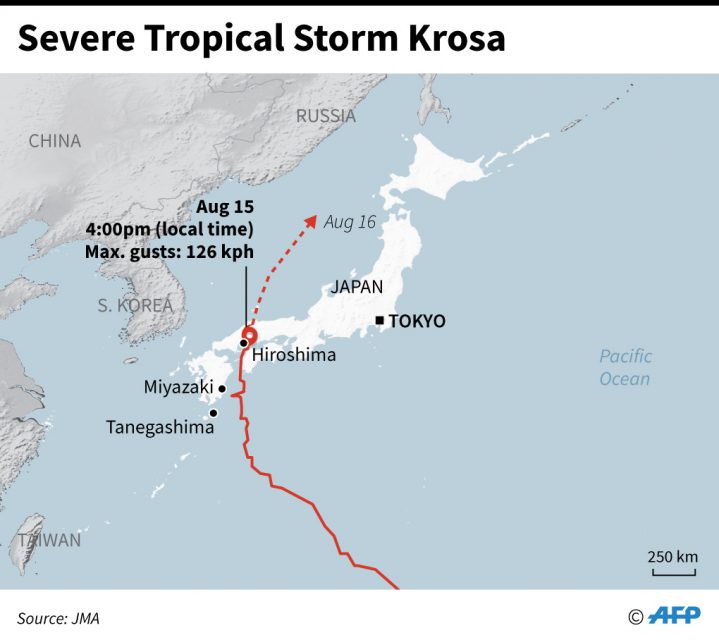
TOKYO, Japan (AFP) — A powerful tropical storm lashed Japan on Thursday, bringing strong winds and torrential rain that claimed at least one life, prompted warnings of landslides and flooding, and sparked evacuation advisories and travel chaos at a peak holiday period.
Severe Tropical Storm Krosa — one notch below a typhoon — slammed into the southern Hiroshima region, packing wind gusts of up to 126 kilometers (78 miles) per hour.
Dramatic television footage showed violent winds uprooting trees, snapping lampposts and spinning pods on a Ferris wheel.
Meanwhile, high waves smashed into a breakwater, engulfing a 10-meter lighthouse, while swollen rivers broke their banks and swamped nearby roads.
Authorities issued a voluntary evacuation advisory to around 430,000 people in the storm’s path, although few appeared to have heeded the warning.
An 82-year-old man was confirmed dead after he fell in the sea in Hiroshima while trying to moor his boat, a local government spokesman said.
Japanese news agency Kyodo reported that a total of 49 people were injured from Wednesday to Thursday.
“We still have intermittent downpours,” said Takayoshi Sugimoto, a disaster management official in the southwestern province of Tokushima.
“We will remain vigilant,” he told AFP.
The national disaster management agency said a party of 18 people, including children, were stranded during a barbeque in a valley when a river rose rapidly on Wednesday. They were rescued Thursday morning.
Krosa also sparked travel chaos as people battled to return to major cities following the Obon holiday.
More than 800 domestic flights were canceled to and from cities in western Japan, and bullet train services were either scrapped or sharply reduced.
Ferries connecting the southern Shikoku island and other parts of Japan were also canceled as high waves lashed the coast.
The storm brought strong winds and downpours to the capital Tokyo.
Several ceremonies commemorating the end of World War II were canceled in western Japan due to bad weather.
Krosa weakened significantly from earlier in the week as it stalled in the Pacific Ocean but it boasts an unusually large eye, meaning it is likely to dump rain over a wide area.
It was moving north at 35 kilometers (22 miles) per hour and the rain was expected to last for an extended period.
The storm crossed Japan’s mainland and hit the Sea of Japan late Thursday.
© Agence France-Presse
